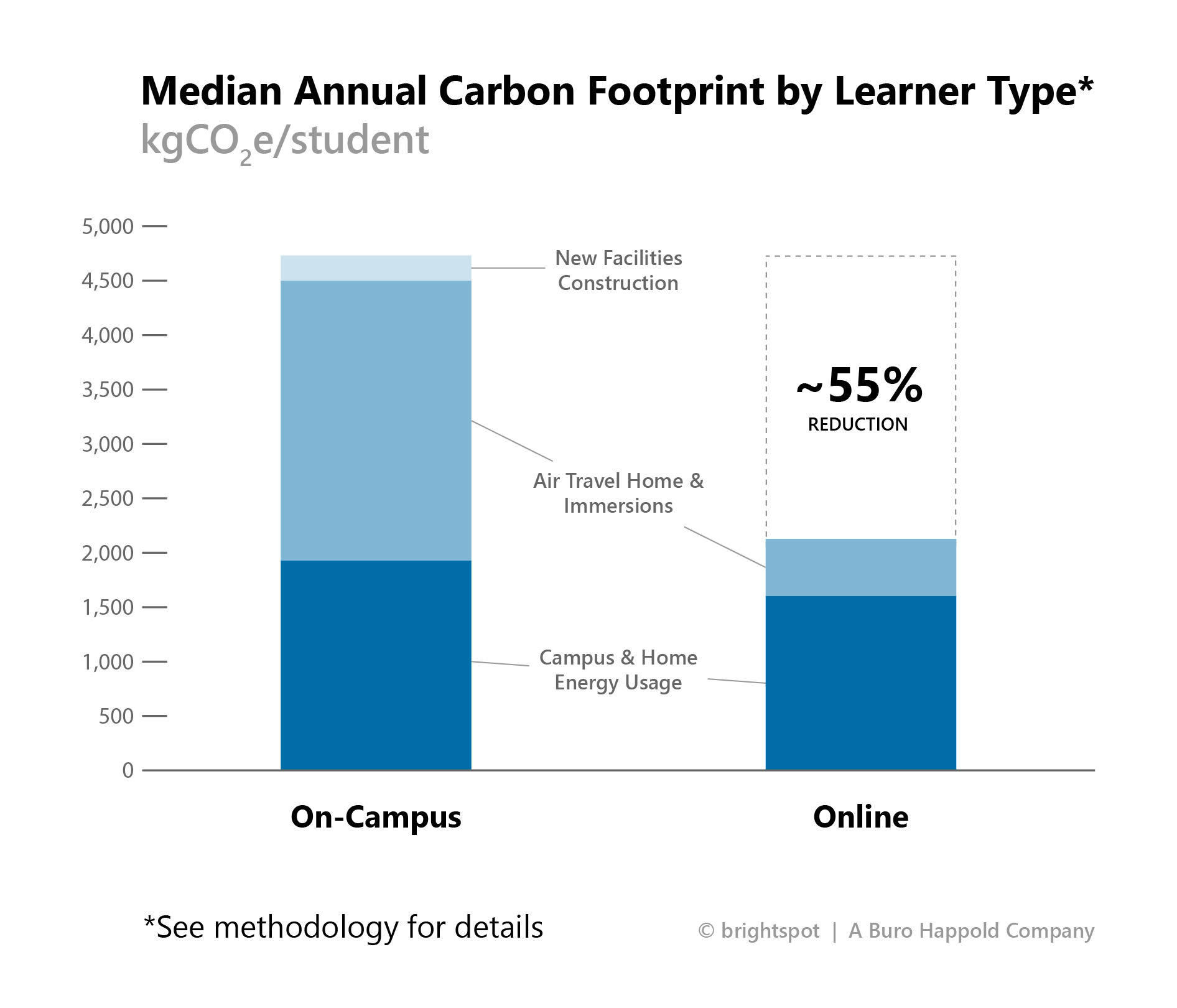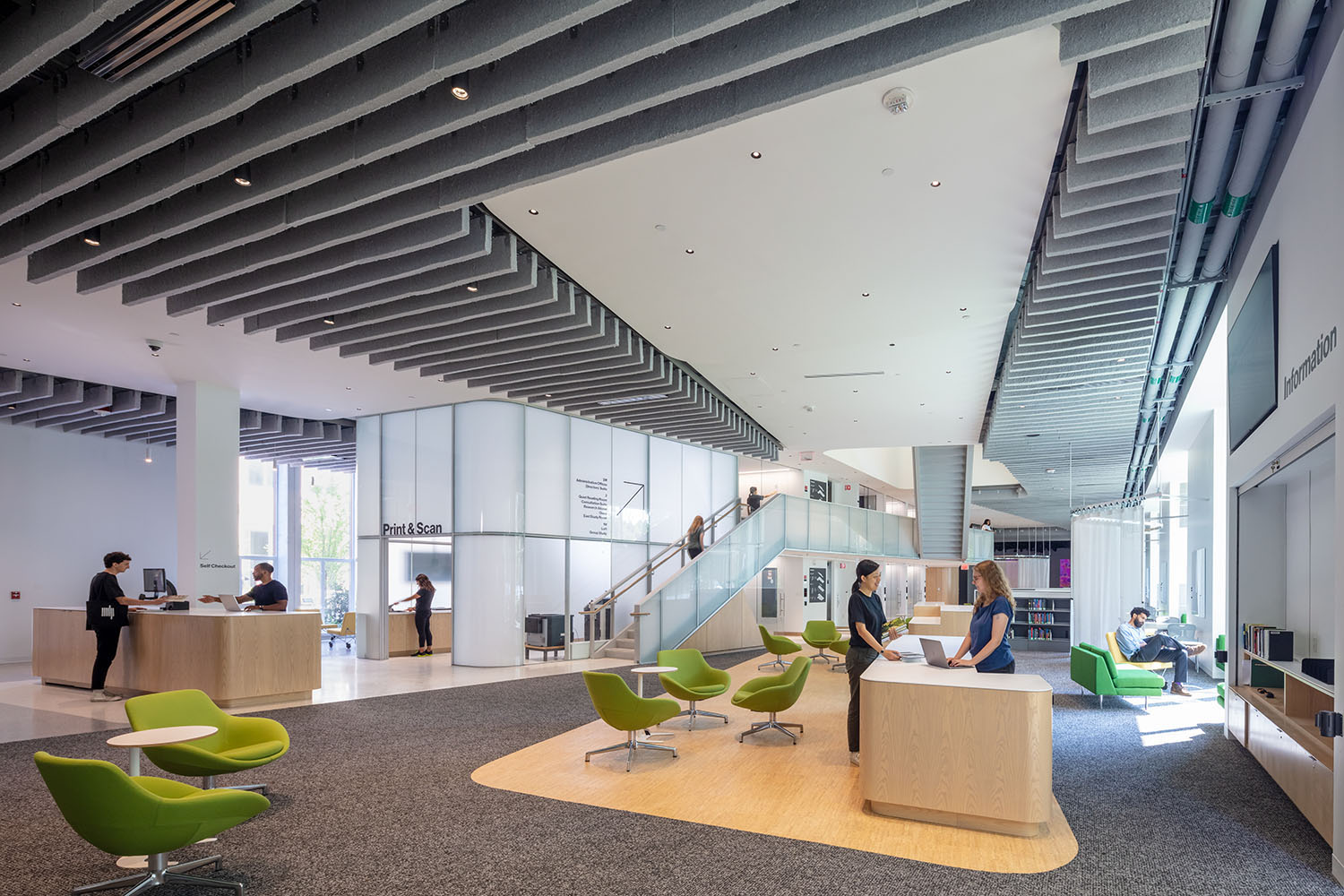Universities are remarkable places that transform peoples’ lives. But neither their financial model nor environmental impact are sustainable.
With more effective use of their facilities, streamlining of administration, and thoughtful adoption of high-quality online learning, colleges and universities can raise enrollment by at least 30%, reducing their carbon footprint per student by 11% and lowering their cost per student by 15% with the same level of instruction and better student support.
Doing this, though, will take some work. We need to change how we think about growth, how we use space, and how we use technology.
First, we have shed the silicon valley narrative on the waning value of college and the doom and gloom fears from the coming demographic cliff. It’s tempting to see state governments dropping degree requirements for their jobs and Google’s plan for 20,000 career certificates as threats. Or assume decreased demand since 56% of Americans now think a four-year degree is a “bad bet.” But college provides an average of about a million dollars or more in additional lifetime earnings compared to high-school alone and 80% of college grads see an increase in salary sufficient to offset their tuition costs in under ten years.
Yes, there will soon be fewer 18-24 year olds entering college, but that doesn’t mean we need colleges less, it means we need less expensive colleges. Thirteen percent of Americans have some college credit but no degree; about half of those that left did so for financial reasons, down from 69% in 2018.
Second, college and university campuses are great assets but they are underutilized. Technical requirements will mean that new science buildings are needed periodically but classrooms, offices, libraries, and residence halls can be used more effectively rather than building new ones. The most sustainable building—financially and environmentally—is the one you don’t build.
Modest changes in how we use facilities could yield capacity to serve at least 30% more students in the same amount of space. Using classrooms five more hours per week at 5% higher utilization yields 20% additional classroom capacity.
Nationally, “work from home” has normalized at 30% of the work week. If colleges and universities adopted hybrid work aligning to that, this would save at least 20% space for the additional faculty and staff to teach and support the additional students. To be conservative, let’s assume we only achieve half of these efficiencies and gain 10% capacity to grow in place during the fall and spring. If each student enrolled one summer, that would yield about 10% more capacity on top of this. An additional 10% capacity can come from increased online learning, for a total of 30%.
Most importantly, all of these changes would improve most colleges in the eyes of both students and faculty. A third of on-campus students would like to see their colleges invest in online courses. While it may not be for everyone, fully online options continue to grow in popularity: both EDUCAUSE and Brightspot found about 20% of undergrads are looking for fully-online options, and there are now more students getting an MBA online than on campus. Sixty-nine percent of Dartmouth students gave high ratings to the summer semester. As for streamlining student services and academic support, that’s the quiet dream of every provost.
Third, better use of space and use of well-designed online learning can reduce the cost and carbon footprint of education. A mid-size public university spends about 25% on instruction, 10% on research, 20% on student support services, 20% on physical plant (including dorms), and roughly 25% on everything else including administration and operations. So, if a college or university increases enrollment online by 30% and keeps instruction and student support services constant, it can lower the cost per student by about 15%.
An online student has about half the carbon footprint of an on-campus student. If you compare the carbon footprint of two MBA students at top universities during a two-year program, an on-campus student will consume about 300 more kilograms of CO2 equivalent (kgCO2e) in stationary energy usage due to higher space needs and will consume about 2,000 more kgCO2e in air travel between campus and home and on global immersions.
The use of online learning and better use of current facilities avoids the construction of new facilities and their associated embodied carbon, the emissions from manufacturing, transporting, installing, maintaining, and disposing of building materials. In this case an additional 250 kgCO2e would also be avoided per student. Growing in place and online rather than building new space is critical since the built environment is responsible for 40% of global emissions considering the embodied carbon to build facilities and the energy to operate them.

The built environment is responsible for 40% of global emissions. Institutions must grow in place and online rather than build new space.
Since 2006, college and university presidents have committed to reduce their emissions and be more sustainable. Campuses have greened their infrastructure and increased their diversity. But most colleges and universities have added space faster than enrollment. Scholars such as Bryan Alexander have recently called attention to the impact of the climate crisis on higher education.
Now is the time to make education more sustainable—socially, economically, and environmentally. More effective use of space and thoughtful adoption of online learning can increase access to education, lower the cost per student, and reduce carbon emissions. Let’s get to work.
A brief note on methodology:
To compare the carbon footprint of online vs. on-campus learners, we considered MBA students in a two-year program and assumed 172 gross square feet per on-campus student based on the average of 15 top business schools. We also conservatively included 90 gross square feet for online students to account for faculty and staff office space, studios, and support space.
We assumed an 800 square foot apartment building off-campus, with on-campus students studying 35 hours a week on campus and 15 hours at home. To calculate emissions, we used Energy Star energy use data to estimate usage, assumed a 56.5% electricity and 43.5% natural gas split, and converted usage into emissions using EPA Emission Factors.
For travel, we assumed all online students take one trip to campus a year and that 75% of on-campus students travel to/from campus twice a year – 35% of those internationally. We also assumed that 32% go on a global immersion trip once over their two years based on websites of 20 top business schools. We estimated typical miles flown using the distribution of students relative to the distribution of institutions on a regional basis. Then we converted the miles flown to emissions also using EPA Emission Factors.
For embodied carbon savings, we used benchmarks from the Carbon Leadership Forum study to account for two years of savings over a building’s lifetime, assuming LCA Stage A embodied carbon for building structure, foundation, and enclosure for commercial office buildings.
ABOUT THE AUTHORS
John Katzman is the founder and CEO of Noodle, which offers a series of technologies and services to make universities more resilient, responsive, efficient, and connected. Before that, he founded and ran The Princeton Review and 2U.
Elliot Felix is the founder of brightspot strategy, a Buro Happold Company. He has worked with more than a hundred colleges and universities to help students succeed with better facilities, support services, and technology, and he is the author of How to Get the Most Out of College.
Related Stories
| Mar 18, 2011
Universities will compete to build a campus on New York City land
New York City announced that it had received 18 expressions of interest in establishing a research center from universities and corporations around the world. Struggling to compete with Silicon Valley, Boston, and other high-tech hubs, officials charged with developing the city’s economy have identified several city-owned sites that might serve as a home for the research center for applied science and engineering that they hope to establish.
| Mar 15, 2011
What Starbucks taught us about redesigning college campuses
Equating education with a cup of coffee might seem like a stretch, but your choice of college, much like your choice of coffee, says something about the ability of a brand to transform your day. When Perkins + Will was offered the chance to help re-think the learning spaces of Miami Dade College, we started by thinking about how our choice of morning coffee has changed over the years, and how we could apply those lessons to education.
| Mar 11, 2011
University of Oregon scores with new $227 million basketball arena
The University of Oregon’s Matthew Knight Arena opened January 13 with a men’s basketball game against USC where the Ducks beat the Trojans, 68-62. The $227 million arena, which replaces the school’s 84-year-old McArthur Court, has a seating bowl pitched at 36 degrees to replicate the close-to-the-action feel of the smaller arena it replaced, although this new one accommodates 12,364 fans.
| Mar 11, 2011
Historic McKim Mead White facility restored at Columbia University
Faculty House, a 1923 McKim Mead White building on Columbia University’s East Campus, could no longer support the school’s needs, so the historic 38,000-sf building was transformed into a modern faculty dining room, graduate student meeting center, and event space for visiting lecturers, large banquets, and alumni organizations.
| Mar 11, 2011
Texas A&M mixed-use community will focus on green living
HOK, Realty Appreciation, and Texas A&M University are working on the Urban Living Laboratory, a 1.2-million-sf mixed-use project owned by the university. The five-phase, live-work-play project will include offices, retail, multifamily apartments, and two hotels.
| Mar 11, 2011
Slam dunk for the University of Nebraska’s basketball arena
The University of Nebraska men’s and women’s basketball programs will have a new home beginning in 2013. Designed by the DLR Group, the $344 million West Haymarket Civic Arena in Lincoln, Neb., will have 16,000 seats, suites, club amenities, loge, dedicated locker rooms, training rooms, and support space for game operations.
| Feb 23, 2011
The library is dead, long live the library
The Society for College and University Planning asked its members to voice their thoughts on the possible death of academic libraries. And many did. The good news? It's not all bad news. A summary of their members' comments appears on the SCUP blog.
| Feb 11, 2011
Sustainable features on the bill for dual-building performing arts center at Soka University of America
The $73 million Soka University of America’s new performing arts center and academic complex recently opened on the school’s Aliso Viejo, Calif., campus. McCarthy Building Companies and Zimmer Gunsul Frasca Architects collaborated on the two-building project. One is a three-story, 47,836-sf facility with a grand reception lobby, a 1,200-seat auditorium, and supports spaces. The other is a four-story, 48,974-sf facility with 11 classrooms, 29 faculty offices, a 150-seat black box theater, rehearsal/dance studio, and support spaces. The project, which has a green roof, solar panels, operable windows, and sun-shading devices, is going for LEED Silver.
| Feb 11, 2011
Research facility separates but also connects lab spaces
California State University, Northridge, consolidated its graduate and undergraduate biology and mathematics programs into one 90,000-sf research facility. Architect of record Cannon Design worked on the new Chaparral Hall, creating a four-story facility with two distinct spaces that separate research and teaching areas; these are linked by faculty offices to create collaborative spaces. The building houses wet research, teaching, and computational research labs, a 5,000-sf vivarium, classrooms, and administrative offices. A four-story outdoor lobby and plaza and an outdoor staircase provide orientation. A covered walkway links the new facility with the existing science complex. Saiful/Bouquet served as structural engineer, Bard, Rao + Athanas Consulting Engineers served as MEP, and Research Facilities Design was laboratory consultant.















